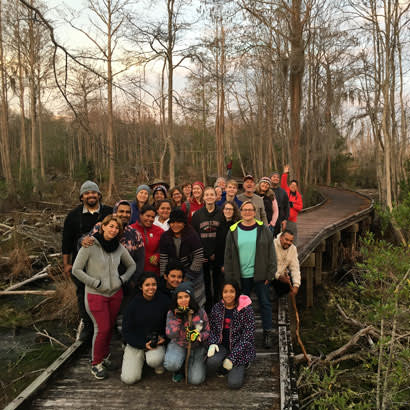
When most people think of New Year’s Day, things like family, friends, food and festivities come to mind. However, thanks to a rapidly expanding initiative, designed to get more people active and outdoors, a new activity has been added to that traditional mix. This year, on January 1, record numbers of “First Day Hikers” are expected to flock to parks around the country. New research suggests that park managers who capitalize on this phenomenon could build connections with visitors and generate positive recreation and stewardship outcomes that last well beyond New Year’s Day.
What are First Day Hikes?
Initiated in Massachusetts in 1992, the First Day Hikes concept emerged as a way to get more people in parks and enjoying nature during a season (winter) not typically associated with outdoor recreation. The hikes quickly grew in scope and popularity. In 2012, when the National Association of State Park Directors (NASPD) began administering the program, all 50 state park systems held at least one First Day Hike for the first time, and participation in the program has continued to grow. By 2017, the First Day Hike program offered more than 1,300 guided hikes that attracted more than 62,000 hikers, making it one of the most popular recreation events in the country.
Although typically hosted within state parks, First Day Hikes are made possible by the work of many individuals at the local, state and national levels. The hikes are typically free, with many sites only requiring a park entrance fee (if applicable). Partnerships with local entities (e.g., friends groups, hiking clubs), national organizations (e.g., American Hiking Society) and governmental agencies (e.g., National Park Service, U.S. Forest Service) help to support the event and programming in certain areas.
Who are the First Day Hikers?
Despite the popularity of First Day Hikes, little is known about the hikers themselves. To learn more about them, our team studied participants across three of the most popular First Day Hike states: Georgia, Massachusetts and South Carolina. On January 1, 2016, we asked 1,934 adults attending the state park hikes to complete a brief questionnaire. We then followed up with a smaller group of those hikers via a web survey about six months later. Most participants (60 percent) were first-time First Day Hikers, and many (36 percent) were visiting a park they had never visited previously. For 4 percent of participants, this represented their first hiking experience of any kind. Almost half of the participants (49 percent) were hiking with their family and many were hiking with friends (16 percent). Children accounted for about one-third of the makeup of the hiking groups.
What are the benefits of the First Day Hike experience?
According to hikers, the most important benefits associated with the experience were exploring the natural world, spending time with family, exercising and improving physical health, and relaxing and reducing stress — all benefits commonly associated with other forms of park-based recreation. First Day Hike participation was also a predictor of future recreation participation, with more than 90 percent of participants interested in attending future organized hikes. In the sixth months following their First Day Hike, 82 percent of participants visited at least one state park. Park visitation increased for 37 percent of respondents, and hiking frequency increased for 41 percent.
The hikes appeared to impact the outdoor recreation patterns of youth as well. Hikers with children reported that nature-based activities increased for 35 percent of youth participants and hiking frequency increased for 40 percent. First Day Hikers were also likely to support parks and recreation in other ways. For example, 78 percent of hikers said they talked to others about park-related issues and 60 percent said they had donated money to support parks. This collective evidence suggests that park managers could use First Day Hikes to strengthen bonds with their existing visitor base and create connections with new audiences, ultimately building a stronger community of outdoor recreation enthusiasts and park advocates.
What are the next steps for First Day Hikes?
As the program continues to expand, new challenges have emerged. Management recommendations derived from our data highlight the need for a more targeted emphasis on marketing and recruiting efforts focusing on specific subgroups of hikers, such as first-time hikers, families with children and racial/ethnic minorities. Because many hikes had more than 100 attendees, there is also a need to improve crowd control with visitor-use management and creative interpretation strategies that enhance visitor experiences. Responses also suggest that some parks could do more to emphasize post-hike engagement and future recreation and volunteer opportunities, helping to foster more enduring connections between First Day Hike participants and the parks they are visiting. By addressing these challenges, managers could increase the broader impacts of the already rewarding First Day Hike experience.
How do I get involved?
If you resolve to join the movement this New Year’s Day, learn more about First Day Hikes and how to get involved. You can also contact your state or national coordinator to receive a toolkit with directions and suggestions for successfully planning, marketing and implementing First Day Hikes at your site.
Lincoln R. Larson, Ph.D., is an Assistant Professor in the Department of Parks, Recreation & Tourism Management at North Carolina State University. Sarah R. Wilcer is an Interpretive Park Ranger at Grand Teton National Park. Jeffrey C. Hallo, Ph.D., is an Associate Professor in the Department of Parks, Recreation & Tourism Management at Clemson University.

